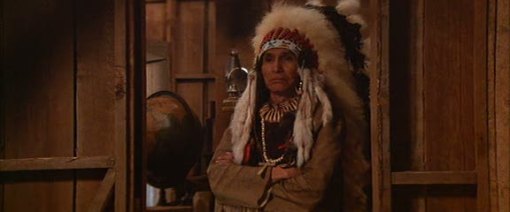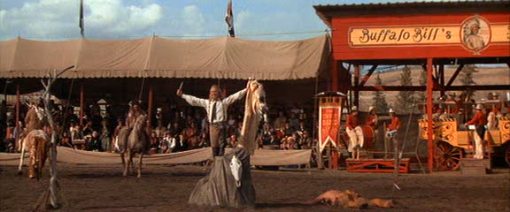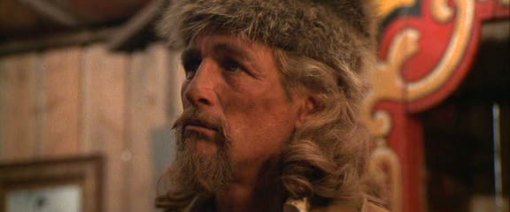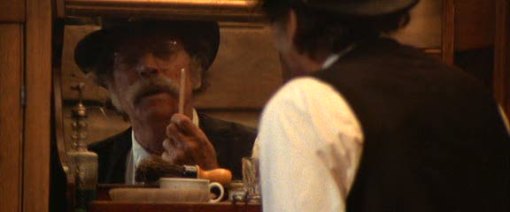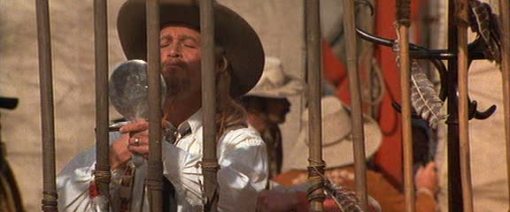The film now moves into its final and the most glorious set piece. What, in a lesser film, could have been simply an exercise in liberal white guilt is elevated into the realm of the unreal and the mythical: Bill’s King Lear-like descent into madness. We see, through a door, Bill waking up suddenly and telling himself that he doesn’t dream. Evidently he was/is in some sort of a sour dream. He is not in his costume and doesn’t have his wig on. He is, literally, stripped down from his mass persona to what he essentially is. He comes to the main room to see Sitting Bull sitting in full costume. Bill tells himself that Bull isn’t there at all. We realize that we are, in a way, in Bill’s psychospace. It’s just Bill and Bull now. Bill goes towards his bar, mumbling: “I hate women” for some reason. (The Coloratura’s probably insulted him and left him as well). The interiors of the room seem emptier than ever, almost Wellesian, with the camera carving out deep spaces hitherto unseen. Bill pours himself a big one. Bull sits alongside a poster of Bill. Cut to Bill. Cut back to Bull. He’s standing right next to the poster. Bill stares at him and says: “You ain’t even the right image”. Like an exacting filmmaker, the right image is what Bill is after in the whole film.
He asks the absent Halsey to leave the room and shouts: “Chief! Halsey’s got all the brains. Except he doesn’t mean a word he says, which is why he sounds so real”. A man in the hyperreal highway, Bill’s idea of real is that which sounds and looks more authentic than one which is more truthful. The Wild West show, itself, is a simulacrum, with its own internal logic and without any relation to reality, whose value is measured with parameters like “performance” and “believability” rather than veraciousness, (Halsey, like Bill, is a man with an imposing outside and a seemingly nonextant inner personality. In a way, Halsey is an actor directed by Sitting Bull). Now, Altman’s film, itself, is highly ‘authentic’ in its period setting, eye-popping production design that is marked by an excess of brown colour, décor, costumes and character behaviour. Like many Hollywood films, it seems to take pride in how well it has been able to reproduce an era in fine detail. By critiquing this fetish for surface authenticity, Altman mocks his own film’s claims to veracity. Bill then goes into the adjacent room to “show Sitting Bull something about real”. He comes back with a buffalo skin that he claims he skinned when he was nine. Sitting Bull isn’t there. Bill goes back into his dingy storeroom. “God meant for me to be white” he mutters. The room is nearly dark. Bill in only lit from a far-off source. Only his profile is visible with yet another photograph of his in the background. For the first time in the film, he appears as a complete void with only an outline to hold on to. Bill has been reduced to the absolute lack-of-self that he is. He spots Bull opposite him in bright light. He tells him: “And it ain’t easy. I got people with no lives living through me. Proud people. People to worry about. My daddy died without seeing me as a star. Tall, profitable, good looking”. Another equivalence between Bill and Bull. Bill speaks about ancestors and their continued existence and their dreams like a Native American would. Bill takes responsibility for Custer’s (and American) legacy to such an extent that he simply cannot see himself apart from these figures of the past. Altman described Bill well as a man trapped in someone else’s dream for him.
Bill returns to the well lit main room, back to his surface, personality and image, and yells at Bull: “In 100 years, I’ll still be Buffalo Bill, star! And you’ll be the Injun”. Bill will by over-determined and Bull will be generic indeed. But this typecasting of both is not anything to be proud about. He goes on, before taking another swing and sitting near Bull: “You want to stay the same. Well, that’s going backwards”, without realizing that it is entirely true of himself as well. Bull is indeed Bill’s repressed guilt and a token of America’s repressed history that keeps coming back. (No wonder Bill traces it all back to his childhood). But he’s a lot more as well. Bill and Bull are very much like Ethan and Scarface of The Searchers (1956). Both Bill and Ethan see in the other’s eyes a deep abyss that is themselves. For Bill, though, there’s also a deep mimetic desire, which showed its signs every time Bull went into the arena with a loud applause, which attracts him to the earthiness of Bull more than the physicality Halsey. He tells Bull: “I’m curious, chief. My friends are curious. My women are curious. My fans are curious. And they pay me for it. I give them what they expect. You can’t live up to what you expect. That makes you more make believe than me. You don’t even know if you’re bluffing”. He realizes that the more he watches Bull, the more he realizes that he’s like him. But Bill, internally conflicted more than ever in this segment, resists (in his second hilarious outburst of the film): “The difference between a white man and an Injun, in all situations is that an Injun is red. And an Injun is red for a real good reason. So we can tell us apart”. Bill gets up and moves near the notorious photograph of him on the horse – a superego of sorts – that had taunted him all along. “Ain’t he riding that horse right? If he ain’t, then how come all of you took him for a king?” he says, looking directly into the camera, as though questioning once and for all, the film’s inherent and explicit mythicizing of both Newman and Bill. The voice might just be that of Altman. “Carve our names. And celebrate the event” cries Bill and exits the scene.
A new day, a new show. Nate yells out the last words of the film, which sound not much different from the first lines, thus closing the circle of historical appropriation and ethnic misrepresentation:
“Ladies and gentlemen. For the first time in the history of show business, Nate Salsbury and William F. Cody present a conflict between two of the greatest warriors in western civilization staged with spectacular realism. Behold Chief Sitting Bull warrior of the western plains who has murdered more white men than any other redskin spoiled more white women than any other redskin. This bloodthirsty leader of the Hunkpapa Sioux has challenged Buffalo Bill to a duel to the death! Sitting Bull is played by William Halsey. Buffalo Bill, called “Pahaska” which means “long hair” in Sioux accepts the challenge for his beloved country.”
“Spectacular realism” indeed. Halsey, possibly to save the rest of his clan, takes up the role of Sitting Bull. Finally, the show has someone who looks the part. The huge screen on the left opens up once again, abruptly revealing Bill against a beautiful frontier landscape (very much like the opening of The Searchers). The screen motif is central to the film and its visceral use here invokes (and critiques) traditional westerns with their awesome geography and mythical heroes powerfully. Bill gets down on the field, engages in a condensed hand-to-hand combat act with the substitute Sitting Bull, defeats him and scalps him. He’s scalped more than just Sitting Bull’s hair. He’s scalped an alternate history and possibly the truth as well. Bill gathers the scalp and walks atop a synthetic rock besides the upright flagpole bearing the American flag. The crowd roars, the music soars, Bill gloats. Altman’s camera zooms – and this is one of the best zooms in his body of work – into his face from afar, keeps going until his only his eyes are seen in the frame, composed against plain, blue sky. Bill’s image has become just too big for the frame, it has outgrown it. What was planted firmly in context in a particular geography and time has become a trans-historical floating signifier. Quite simply, Buffalo Bill will be.
—
The most common complaint against Buffalo Bill and the Indians seems to be that the film exhausts its material soon, that it tells us little more than that Bill was a fraud and that it revels in beating a dead horse. Surely, reducing Altman’s film here to the story of a man who defrauded his audience is like saying Citizen Kane (1941) is the story of a selfish man and The Conformist (1970) is the story of an opportunistic man. It is true that the text of all these films is relatively thin, but these films open up indescribable emotional and intellectual avenues that would have been rather roundabout if attempted through the written text. Individually, these three films represent, for me, three great experiments with the filmic form as well as three films that make a strong case for cinema as opposed to text. Decidedly auteurist works, these three films also represent the respective filmmakers in top form, perhaps their best form. What Citizen Kane was to Welles and The Conformist was to Bertolucci, Buffalo Bill and the Indians is to Altman. It’s his masterpiece.
Section






